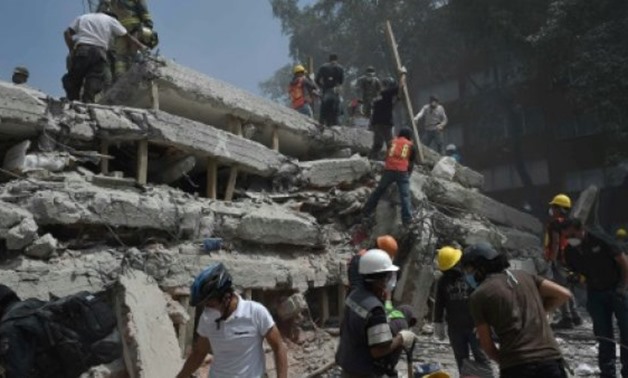
© AFP / by Sofia MISELEM, Sylvain ESTIBAL | Rescuers and volunteers search for survivors amid the rubble and debris of a multistory building flattened by the 7.1-magnitude quake
MEXICO CITY - 21 September 2017: Climbing onto a pile of rubble that used to be a building may not seem the most obvious thing to do for someone who has just survived an earthquake.
But that is how thousands of Mexicans have reacted to the deadly 7.1-magnitude quake that rocked the country Tuesday, killing more than 200 people.
Businessmen in ties, students in jeans, doctors in scrubs and other ordinary people from all walks of life have joined professional rescue teams in rushing onto and into the mangled remains of homes, schools and offices in Mexico City, desperately trying to reach survivors before it's too late.
The outpouring of sympathy has been overwhelming -- too much for the authorities to deal with at times.
Volunteer rescuers are now being turned away at many sites if they do not bring their own helmets. And appeals have gone out for residents of the capital to stop giving perishable food items and water, which have already been donated in abundance.
"Food is going to waste, we don't need any more water. We have a list of medicines and supplies that we need instead," a soldier at one site said through a megaphone in Mexico City's upscale Condesa neighborhood.
Mexico's impressive tradition of citizen solidarity can be traced back to September 19, 1985 -- 32 years to the day before Tuesday's quake -- when another massive earthquake devastated the capital, killing more than 10,000 people.
The government was so overwhelmed by the magnitude of the disaster that citizens took matters into their own hands, organizing teams of diggers, tunnelers, rubble removers, supply managers and the like.
That same determination to band together to dig through the rubble and pull survivors from the wreckage was visible across Mexico City after Tuesday's quake.
Anonymous heroes -
At a collapsed primary school on the capital's south side, where 21 children were killed and several others are believed to be trapped alive, an untrained civilian volunteer took on a starring role in a rescue operation that was being watched around the world.
The slight man was able to squeeze into a narrow channel through the rubble to reach a little girl and pass her water.
His exploits recalled those of the "Moles," teams of slender men who crawled through the wreckage in 1985 looking for survivors. They were so successful they were later deployed to various disaster sites around the world.
Thousands of civilians flooded the scene of the collapsed school, forming human chains to remove rubble under the supervision of the navy.
Others handed out food and water to volunteers. A nearby restaurant had closed its doors but was giving away free food.
One family expressed its moral support by holding up large signs reading "Thank you for your help."
Around the city, cries of joy went up every time workers pulled another survivor from the ruins. More than 50 have been rescued so far, according to President Enrique Pena Nieto.
Then and now -
The 1985 disaster proved to be an earthquake in Mexican politics and society, as well.
It spelled the beginning of the end for one-party rule by the Institutional Revolutionary Party (PRI), the all-powerful party that had governed Mexico since 1929.
Communications networks collapsed, and then president Miguel de la Madrid was nowhere to be seen as devastated residents were left to their own devices in the aftermath of the quake.
It was a wake-up call for a newly organized, newly critical civil society, and also paved the way for an overhaul of the country's disaster preparedness and response systems.
In 2017, communications networks buckled after the quake but didn't break.
The messaging service WhatsApp proved to be a vital means of communication.
Mexico City residents used it to find their loved ones and warn others of danger zones.
Rescue workers said some victims had even been rescued thanks to messages they sent to relatives while trapped under the debris.
That led to a new rallying cry in the capital: "Share your internet!" -- an appeal to residents to remove their wi-fi passwords so trapped victims could access the web.


Comments
Leave a Comment